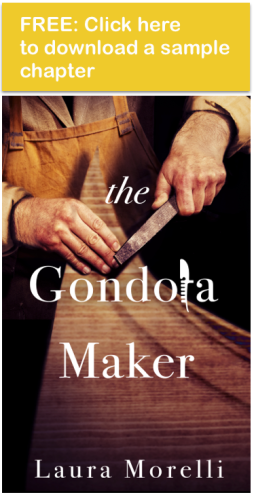Laura Morelli's Blog, page 10
July 17, 2014
Pâte de verre
 Photo: Musée des Beaux Arts (Nancy, France). Jean-Pierre Dalbéra via Flickr
Photo: Musée des Beaux Arts (Nancy, France). Jean-Pierre Dalbéra via Flickr
Pâte de verre–literally “glass paste”–is a technique used to impart a frosted, translucent quality to glass objects.
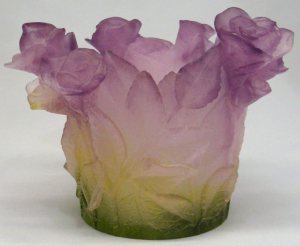 Pâte de verre begins with powdered glass and coloring agents, which are mixed into a gooey paste, then poured into a mold. The technique allows for subtle coloration and patterns such as flowers or swirls in relief across the surface of a vessel. The mold goes into a kiln, where the pâte de verre melts into the intricately carved designs of the mold, and results in a relief pattern once the piece has cooled.
Pâte de verre begins with powdered glass and coloring agents, which are mixed into a gooey paste, then poured into a mold. The technique allows for subtle coloration and patterns such as flowers or swirls in relief across the surface of a vessel. The mold goes into a kiln, where the pâte de verre melts into the intricately carved designs of the mold, and results in a relief pattern once the piece has cooled.
Although this technique has been used since ancient Egypt, French artists in the late nineteenth and early twentieth centuries revived pâte de verre and took it into new directions. Lalique, a glassworks founded by the former jeweler René Lalique (1860-1945) brought pâte de verre into vogue in France thanks to its distinctive Art Nouveau and Art Deco styles.
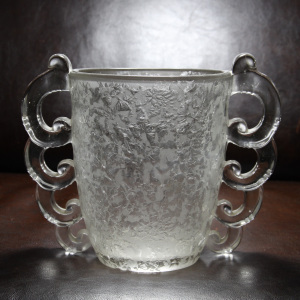 Another glassworks from northeastern France known as Daum pioneered new techniques and styles in pâte de verre, imparting a lovely translucent finish to its popular glass pieces. The Daum factory added lead to the mixture, making it closer to crystal. Daum was founded in 1878 by two brothers, Auguste and Antonin Daum, who left established careers as an attorney and an engineer to take over a glassworks their father had purchased. The brothers quickly became known for their colored lamps, many in the shape of mushrooms and flowers, with wrought-iron bases.
Another glassworks from northeastern France known as Daum pioneered new techniques and styles in pâte de verre, imparting a lovely translucent finish to its popular glass pieces. The Daum factory added lead to the mixture, making it closer to crystal. Daum was founded in 1878 by two brothers, Auguste and Antonin Daum, who left established careers as an attorney and an engineer to take over a glassworks their father had purchased. The brothers quickly became known for their colored lamps, many in the shape of mushrooms and flowers, with wrought-iron bases.
Daum’s real claim to fame, though, is bringing Art Nouveau style to life in glass, with its characteristic natural forms of flowers, grass, leaves, undulating plants, animals, and scrolls. In later years, modern artists such as Salvador Dali designed pieces for Daum in pâte de verre including snails and surrealist vases that appear broken. Today the Daum glassworks is still considered one of the masters of pâte de verre.
For more about authentic shopping in France, click here.
Photo: Musée des Beaux Arts (Nancy, France). Etienne via Flickr








July 14, 2014
Happy Bastille Day!
Happy Bastille Day, friends! July 14 marks the events (including the famous storming of the Bastille in 1789) that marked the French Revolution and the subsequent establishment of the French Federation in 1790.








May 29, 2014
Limoges China: What You Should Know
 Photo: Dawn Smith for Laura Morelli’s
Made in France
Photo: Dawn Smith for Laura Morelli’s
Made in France
Limoges is synonymous with French porcelain or china. These beautiful wares, valued for their translucence and fine workmanship, have brought this sleepy town in central France to a global stage.
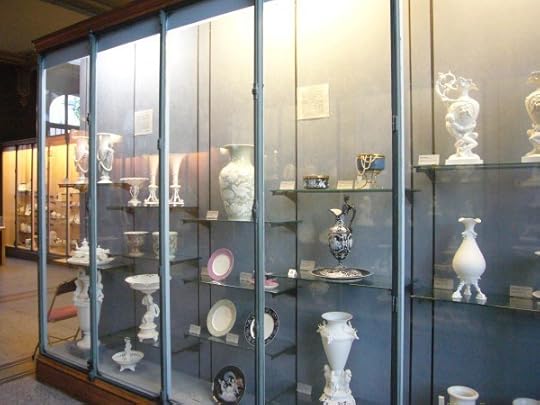
Musée Nationale de la Porcelaine Adrien Dubouché (Limoges, France)
Pure, milky-white porcelain is possible thanks to kaolin, a white argile discovered in the eighteenth century thirty kilometers from Limoges in Saint-Yrieix-la-Perche. People recognized its potential, and in the 1770s, an established faience factory in Limoges turned to creating porcelain with it. This factory would later become the Manufacture Royale de Limoges.
Porcelain results from a unique recipe that consists of fifty percent kaolin, twenty-five percent felspath and twenty-five percent quartz. It’s this combination that results in the translucent, shiny finish coveted by collectors around the world. Most pieces are built in a mold, and undergo a first firing before being painted. A second firing gives it the lustrous sheen that is synonymous with Limoges ware.
Though there are many producers of Limoges porcelain, four big names dominate the town, and still produce the best wares— Ancienne Manufacture Royale de Limoges, Bernardaud, Haviland, and Raynaud. Even though they are major powerhouses of porcelain production and world brands, these four companies are still family operations, and much of the production is still carried out by hand.
For more about authentic shopping in France, click here.








May 22, 2014
Longwy Enamels: A Unique French Ceramics Tradition
The French town of Longwy, in the region of Lorraine near the Belgian border, is home to a unique tradition of laying enameled colors–cloisonné–on top of ceramic vessels.
The French term cloisonné literally means “compartmentalized,” referring to discrete sections of rich color. We usually think of cloisonné as a jewelry-maker’s technique; a jeweler creates a “skeleton” using bronze, gold, or silver strips or wires, then fills each compartment with molten enamel to achieve bright colors and a bold design in pendants, beads, and other pieces. However, the technique is also used in ceramics, especially in Asia, where it originated. So how did this laborious Asian technique of cloisonné ceramics make its way to this sleepy French town?
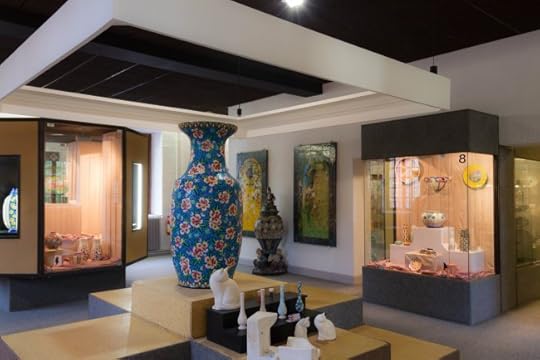
Musée des émaux Longwy
In the late 1700s, the popularity and commercial success of Asian ceramics inspired ceramicists in Longwy to achieve this technical feat. In 1798, Charles Régnier founded a faïencerie, or establishment for making faience, in Longwy-Bas, the lower part of town. By the 1820s, artisans were creating the beautiful saturated enamels, including a full range of blues from royal to turquoise, and the now-characteristic bleu de Longwy. It’s this distinctive color–not quite turquoise–as well as the finely crackled effect of the enamel across the surface, that distinguishes Longwy enamels, or émaux de Longwy.
The faïencerie experimented with an enamel technique of applying a white, opaque glaze that allowed them to carve designs in relief on the surface of a vessel, imitating cloisonné compartments separated by metal. By the end of the 1800s, they had refined the technique by creating carved relief and at the same time imparting a slick, reflective quality to the entire surface. The pieces underwent several firings in the kiln, as well as an extensive finishing process.
Only a handful of ceramicists carry on the particular tradition of Longwy enamels today. You may be surprised at the steep prices of these pieces–often several hundred Euro for a plate or a vase–which is the result of the intensive labor involved in producing these beautiful wares.
For more about authentic shopping in France, click here.








May 7, 2014
It’s official! The Gondola Maker is an award-winning novel
It’s official! The Gondola Maker is an award-winning novel!
In addition to being named a finalist for the da Vinci Eye Prize, as of today The Gondola Maker has won an IPPY award in the category of Best Adult Fiction E-book! I’ll be headed to New York later this month for the awards ceremony. Thank you, friends, for all your support of this project!
Click here for a full list of IPPY award winners.
Click here for more information about The Gondola Maker and click here to download a sample chapter.
Click here to visit Laura Morelli’s author page at amazon.








May 6, 2014
Guatemalan Textiles
 Beneath a shade tree in the Guatemalan highlands, women gather to weave. They talk and laugh as they interlace brightly colored threads on simple backstrap looms, virtually identical to the looms their Maya ancestors used some 1,200 years ago.
Beneath a shade tree in the Guatemalan highlands, women gather to weave. They talk and laugh as they interlace brightly colored threads on simple backstrap looms, virtually identical to the looms their Maya ancestors used some 1,200 years ago.
Most of these women have been weaving for as long as they can remember, following the example of their mothers and grandmothers. For them, weaving is as much a part of the day’s domestic duties as cooking, cleaning, working in the fields, and caring for children. Today’s weavers descend from the ancient Maya, whose civilization developed across a wide swath of Central America from the second millennium B.C. onward. Over centuries, weavers in each village developed their own characteristic patterns and colors of clothing, portraying their communal identities much like a dialect. On a blank canvas of fabric, they repeated characteristic geometric designs, stripes, flowers, birds, and animals using brocading and embroidery techniques.
Read more of Laura Morelli’s “The Genuine Article” at National Geographic Traveler…
For more on authentic shopping, click here.








May 3, 2014
10 Reasons to Love Limoncello
It’s yummy! Well, most of the time. Truthfully, bad limoncello tastes like window cleaner. Good limoncello tastes pure, refreshing, and oh-so-lemony–the perfect way to end a great meal on a summer day.
It’s deceivingly simple. Limoncello is little more than fresh lemon peels, pure alcohol, sugar, and water, but there are many secrets. If a professional or amateur limoncello maker shares their secrets (like marinating the rinds, using the seeds, and many others), consider yourself an insider!
It’s authentic. The famous ovale di Sorrento, or “Sorrento oval,” is the giant lemon variety that gives limoncello from Sorrento its distinctive taste. The sfusato amalfitano, the variety of lemon grown in nearby Amalfi, is also considered excellent for making limoncello.
It’s historic. People have been growing lemons on the cliff sides of the Amalfi coast since the early Middle Ages. It must not have been long before they figured out how to turn them into limoncello and many other lemon-infused pastries and other dishes.
It’s a great excuse to travel to the Amalfi Coast. Ask any Italian, and they’ll probably tell you that lemons from Sorrento make the best limoncello in the world. The tart fruits flourish along the hillsides of this volcanic earth, rich with sunshine and salt air.
It’s a good way to meet the locals. Many Italians grow lemons in their gardens so that they can make their own homemade limoncelli. My former neighbor near Milan makes a wonderful, sweet homemade limoncello infused with blueberries from her garden!
You can buy good artisanal limoncello all over Italy, from the Alps to Sicily. In a large city like Naples you will get a better selection of the limoncello from the Amalfi region because of geographical proximity. However, you should also look for local producers in the other towns you visit.
It’s surprisingly affordable. It is easy to find even a great limoncello well under 50 Euro.
It’s a good reason to visit your local wine merchant. Keep your eyes out for a good enoteca (wine shop) or one of those little shops that sells high-end prepared foods and specialty culinary items. Ask the owner for a personal recommendation. Aside from the more industrial producers like Luxardo and Petrone, there is a tremendous variety of limoncello made by small, family producers. Many of the culinary shop owners will have hand-picked a few favorites to carry in their stores, and that’s usually a good bet.
It’s a good idea to savor limoncello in Italy. If you want to bring home a bottle of limoncello or other alcoholic beverages, be sure to check your country’s customs regulations before you buy.
Good luck limoncello-hunting in Italy! Salute!
Click here to find out how to find good limoncello even if you’re not going to Sorrento.
For more of my tips on authentic shopping in Italy, click here.








May 2, 2014
Why I Love Naples, Italy
A Lebanese friend of mine once aptly described Naples, Italy to me as “Beirut without the bombs.”
Naples, Italy–chaotic, dirty, loud, steamy–is a city of pure spectacle. It is one of my favorite cities in the world. My Milanese friends laugh and tell me I’m crazy, but I’m in love with Napoli. Maybe it’s my Southern upbringing, my love of the sea, or my appreciation for dark humor and beauty in unexpected places, but I feel at home in Naples. Whatever the reason, I relish the city’s chaos, its rhythm, and its fascinating nooks and crannies.
Nearly anyone who’s ever visited Napoli has a story, and some of them, unfortunately, contribute to its reputation as a city full of shady characters. I can tell my own tales, including having to move a heavy piece of furniture in front of a hotel room door, but I’ll save those for another time. Trust me: You will not be bored in Naples.
In its artistic traditions, Napoli embodies all the sophistication, originality, and unbridled exuberance of Italian culture: cameos, Capodimonte porcelain, coral jewelry, copper and wrought iron, fantastic nativity and religious figures crafted of papier-mâché (the city’s famous presepe and pastore).
Italians have a wonderful expression–”Che dramma napoletano!” (What a Neopolitan drama!)–and I can think of no other word that’s more perfect than “drama” to sum up this wonderful city.
Recently I shared some of my favorite haunts in Napoli with Departures Magazine. Click here to see them.
For more of my tips for shopping on Italy, click here.








April 30, 2014
The Gondola Maker: Book Trailer
 In 16th-century Venice, the heir to a gondola-making boatyard rejects his destiny, only to be drawn to restore an antique gondola with the dream of taking a girl for a ride.
In 16th-century Venice, the heir to a gondola-making boatyard rejects his destiny, only to be drawn to restore an antique gondola with the dream of taking a girl for a ride.
Click here for more information and to download a sample chapter.
Click here to visit Laura Morelli’s author page at amazon.








April 29, 2014
Antiquing Across the American Southwest
 Antiquing tops the to-do list of many visitors to the American Southwest. The region’s rich melting pot of Hispanic, Native American, and Western cultures, as well as its colorful history, makes hunting for old-fashioned treasures one of the Southwest’s most enjoyable pastimes. Treasure-hunters can become overwhelmed quickly though by the sheer number of choices in the shops and markets, from Spanish Colonial furniture and Western apparel to Native American pottery and rugs.
Antiquing tops the to-do list of many visitors to the American Southwest. The region’s rich melting pot of Hispanic, Native American, and Western cultures, as well as its colorful history, makes hunting for old-fashioned treasures one of the Southwest’s most enjoyable pastimes. Treasure-hunters can become overwhelmed quickly though by the sheer number of choices in the shops and markets, from Spanish Colonial furniture and Western apparel to Native American pottery and rugs.
These tried-and-true tactics will help you go home with a piece you’ll prize for many years, whether your antiquing goals are to buy a quality souvenir, start a collection, or hunt for an investment-grade treasure that will gain value over time…
Read more of this article at Laura Morelli’s “Certified Southwest” column for Su Casa Magazine…
For more on authentic shopping, click here.









